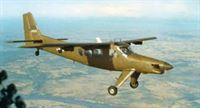Фотографии
-
Регистрационный номер: N9760Z By 1974 most of the Cambodian towns besieged by the Khmer Rouges were surviving almost entirely owing to the air bridges put in place by the KAF and local charter airlines. Here Curtiss C-46 N9760Z of the Phnom Penh-registered Tri-9 Corporation taxies out for another sortie from an improvised airstrip at Kampong Cham.
Самолёты на фотографии: Curtiss-Wright C-46 / CW-20 Commando - США - 1940
-
All departures and arrivals of the transports involved in the Phnom Penh "air bridge” in 1975 had to be covered by KAF T-28s or gunship helicopters. Here a T-28D of the Groupe d’Intervention, fitted with four napalm tanks, takes off to provide an Airlift International DC-8-63 with top cover before the latter departs Pochentong.
Самолёты на фотографии: Douglas DC-8 - США - 1958North American T-28 Trojan - США - 1949
-
North American T-28D-15 serial 51-7555 of the Khmer Air Force Groupe d’Intervention’s fighter squadron, based at Battambang in 1973, loaded with a standard configuration of four Mk 82 500lb bombs.
Самолёты на фотографии: North American T-28 Trojan - США - 1949
-
A pair of bomb-armed T-28Ds taxy out at a primitive makeshift airstrip for a ground-strike sortie in support of Cambodian troops in the besieged Kampong Thom enclave. The nearest aircraft, serial 51-3583, went on to serve with the Philippine Air Force after leaving Cambodian service in 1975.
Самолёты на фотографии: North American T-28 Trojan - США - 1949
-
Cessna O-1D serial 57-2903 was transferred from the Royal Lao Air Force to the KAF in February 1974 for KAF pilot training at Udorn in Thailand, before being sent to Pochentong that June, when it was officially transferred to the KAF inventory for active service.
Самолёты на фотографии: Cessna L-19 / O-1 Bird dog / Model 305 - США - 1950
-
In mid-1973 Su Sampong was appointed CO of the Groupe Aerien d’Observation et d’Accompagnement au Combat (GAOAC), at that time still using several Cessna O-1As of the original batch delivered in 1956. These carried the new unit’s insignia on their fins but retained their former Royalist national markings, as seen here.
Самолёты на фотографии: Cessna L-19 / O-1 Bird dog / Model 305 - США - 1950
-
One of the ten KAF C-123Ks that escaped to Thailand after the fall of Phnom Penh on the apron at Don Muang Airport in Bangkok. For readers interested in finding out more about Cambodian military aviation and the Khmer Air Force, visit the fascinating website established by the late Brig-Gen So Satto at www.khmerairforce.com.
Самолёты на фотографии: Fairchild C-123 Provider - США - 1949
-
Following his seven-month stint at the USAF’s Squadron Officer School in the USA, Su Sampong returned to Cambodia in the summer of 1974, when he was appointed Operations Officer of the Groupe de Transport. He is seen here second from right, with fellow crewmembers of a Fairchild C-123K, which has been named Kung Fu.
Самолёты на фотографии: Fairchild C-123 Provider - США - 1949
-
Previously converted for the aerial defoliation role, UC-123K serial 54-578 joined the KAF in August 1973. It is seen here having sunk a mainwheel into an unseen hole while using a stretch of road to offload supplies to an Army garrison, highlighting the conditions in which the Cambodian transport crews were forced to operate.
Самолёты на фотографии: Fairchild C-123 Provider - США - 1949
-
A total of 14 Helio AU-24A Stallion gunships was received by the KAF during 1973-74, including 72-1322, seen here on a sortie in May 1973, one of three that escaped to Thailand in 1975. Despite its remarkable STOL capabilities, the type was not popular with its KAF pilots; two were lost in accidents and three were shot down.
Самолёты на фотографии: Helio H-550 / U-24 Stallion - США - 1964
-
In 1973 Su Sampong became a flying instructor at the Air Academy, teaching on the Cessna T-41D. Here are three students of the 10th Class and a Taiwanese instructor (second left).
Самолёты на фотографии: Cessna 172 Skyhawk / 182 Skyline / T-41 - США - 1955
-
Регистрационный номер: N33AC The KAF C-123Ks were supplemented in the Phnom Penh air bridge operations by contracted civilian transports, including a sole Aviation Traders Carvair, N33AC, named Barb, operated by Air Cambodge, Cambodia’s national flag-carrier. It is seen here taxying in at Pochentong after another resupply run to a besieged town or city.
Самолёты на фотографии: Aviation Traders ATL.98 Carvair - Великобритания - 1961
-
Регистрационный номер: N5135 Lockheed 18 Lodestar N5135 (c/n 18-2496) was leased from Ken Benesh by air taxi company Indhanu Airlines, co-founded by Su Sampong’s sister, Sokhomaly Suon Kaset, in the wake of the cessation of American military operations in Cambodia in August 1973. The aircraft later escaped to Singapore, where it was scrapped.
Самолёты на фотографии: Lockheed Lodestar L-18/C-59/R5O - США - 1939
Статьи
- -
- A.Arthy - Dieppe. The Luftwaffe Perspective
- A.Grandolini - On the wings of the Hansa (3)
- G.Smith - Pan Am's "Rogue" Atlantic Clippers
- K.Hayward - The Stop & Go Show
- K.Lande - Flash!
- L.Andersson - Turkish dismay
- L.Hellstrom - Sabena's Congo Ventilators
- M.Bearman - The other sound barrier
- N.Stroud - How quiet is our STOL?
- P.Davidson - Off the Beaten Track...
- P.Jarrett - Lost & Found
- R.Lezon, S.Rivas - The patagonian eagle
- T.Singfield - "A very nasty situation..."
- V.Flintham - Rover David (2)












